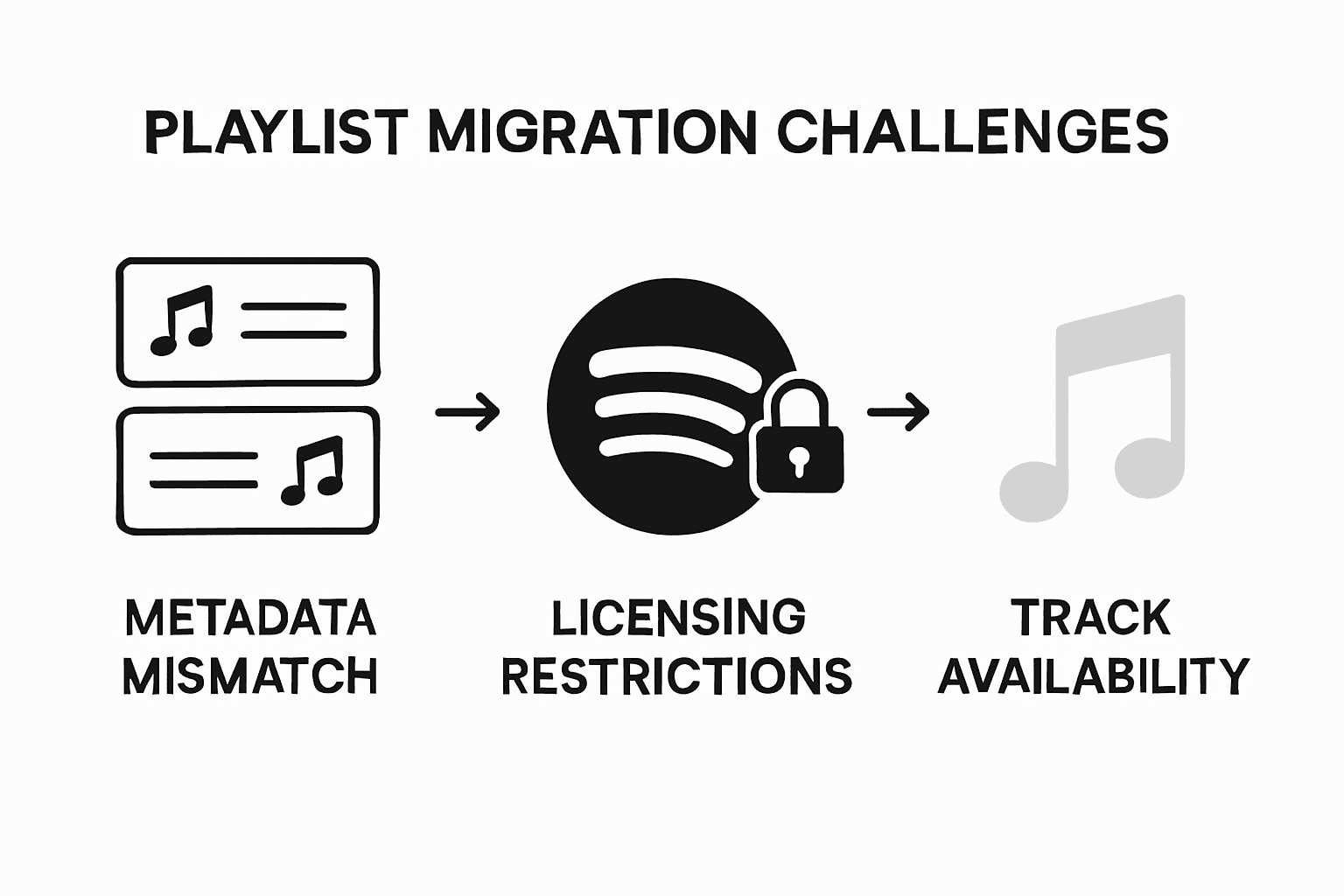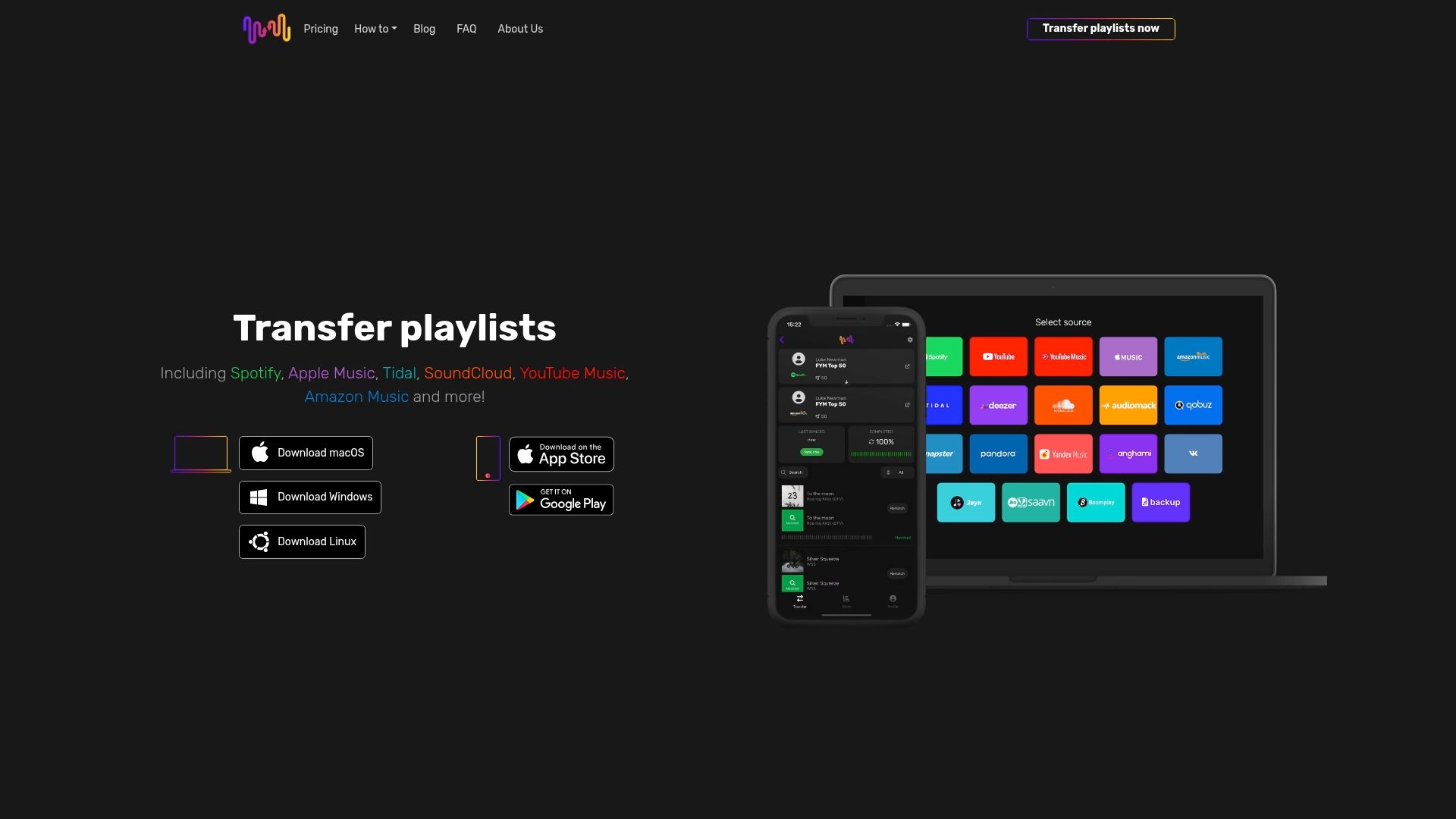Millions of music lovers spend hours curating playlists filled with their favorite tracks and memories. Switching streaming services sounds easy, right? Not so fast. Up to 22 percent of song matches can be lost in transfer due to tricky differences in how platforms handle track data. That means your beloved playlist could come back full of gaps and surprises if you do not know what you are doing.
Table of Contents
- The Importance Of Playlist Migration
- Key Concepts In Playlist Migration
- Challenges In Transferring Playlists
- Best Practices For Successful Playlist Migration
Quick Summary
| Takeaway | Explanation |
|---|---|
| Playlist migration enhances user satisfaction. | Seamless migration preserves curated playlists, boosting emotional connections and engagement across platforms. |
| Maintaining metadata is crucial. | Accurate metadata matching ensures songs transfer correctly, preserving playlist integrity and musical experience. |
| Prepare thoroughly before migration. | Creating backups and documenting playlists minimizes data loss and ensures a smoother transfer process. |
| Understand platform limitations. | Knowing licensing agreements helps avoid issues with unavailable tracks, ensuring more complete playlist transfers. |
| Use advanced migration tools. | Utilizing sophisticated tools with intelligent matching increases the reliability of playlist transfers, leading to higher user satisfaction. |
The Importance of Playlist Migration
Music lovers invest significant time and emotional energy into crafting personalized playlists that reflect their unique musical journeys. Playlist migration has become increasingly crucial as streaming platforms proliferate and users seek flexibility in their music consumption. Research from PLOS One reveals that music playlist preservation directly impacts user satisfaction and engagement across digital platforms.
Understanding Music Library Portability
Playlist migration represents more than a technical process—it is about maintaining personal musical narratives. When users switch streaming services, they risk losing carefully curated collections that often span years of musical exploration. The ability to transfer playlists ensures continuity, preventing the frustrating scenario of manually recreating extensive libraries across different platforms.
Preserving Musical Memories and Recommendations
Each playlist tells a story.
Learn more about seamless playlist transfers with tools designed to preserve not just song lists, but the intricate musical memories associated with them. By maintaining playlist structures during migration, users retain the context and emotional connection embedded within their music collections.
Key benefits of playlist migration include:
- Maintaining personalized music curation
- Preserving listening history and algorithm-based recommendations
- Reducing time spent manually rebuilding playlists
- Ensuring uninterrupted music enjoyment across platforms
The process goes beyond simple song transfers—it is about protecting personal musical experiences and ensuring uninterrupted access to the soundtracks of our lives.
Key Concepts in Playlist Migration
Playlist migration involves intricate technical and digital processes that enable seamless music library transfers between different streaming platforms. Research from Applied Sciences indicates that successful playlist migration requires sophisticated metadata matching and track identification techniques.
Metadata Mapping and Track Identification
At the core of playlist migration lies the complex challenge of metadata normalization. Different streaming services store song information uniquely, making direct transfers challenging. Platforms must navigate variations in artist names, track titles, album information, and unique identifiers to ensure accurate song matching.
Structural Preservation and Algorithmic Compatibility
Playlist migration is not merely about transferring individual songs but maintaining the original playlist structure and listening experience. Explore seamless playlist transfers that preserve song order, playlist naming conventions, and user-generated annotations. This process requires advanced algorithmic approaches that can interpret and reconstruct playlist architectures across diverse platforms.
Key technical considerations in playlist migration include:
- Precise metadata matching algorithms
- Cross-platform track identification mechanisms
- Preservation of playlist sequencing and metadata
- Handling of platform-specific song variations
- Managing potential track unavailability during transfers
Understanding these foundational concepts illuminates the sophisticated technological infrastructure required to facilitate smooth and reliable music library transitions.
Challenges in Transferring Playlists
Playlist migration is fraught with technical and logistical obstacles that can significantly complicate the transfer process. Research from IEEE Communications highlights the intricate challenges users encounter when attempting to move their music libraries between streaming platforms.
Metadata Inconsistencies and Track Matching
One of the most significant barriers in playlist migration involves metadata discrepancies across different streaming services. Each platform maintains unique song identification systems, making precise track matching extraordinarily complex. Artists with similar names, alternate track versions, and regional music catalog variations create substantial challenges in maintaining playlist integrity during transfers.
Licensing and Availability Restrictions
Streaming platforms operate under distinct licensing agreements, which directly impact music availability. Explore complex playlist transfer scenarios where certain tracks might exist on one platform but remain unavailable on another. These licensing constraints can result in incomplete playlist transfers, forcing users to manually replace missing tracks or accept partial migration results.
Primary challenges in playlist migration include:
- Inconsistent metadata across streaming platforms
- Variations in track availability and licensing
- Regional music catalog differences
- Platform-specific audio quality variations
- Preservation of original playlist ordering and context
Navigating these challenges requires sophisticated technological solutions that can intelligently map and transfer music collections while maintaining as much of the original playlist structure as possible.
The table below compares the key challenges users face during playlist migration and explains why each challenge matters.
| Challenge | Description |
|---|---|
| Metadata Inconsistencies | Variations in song information (artist names, track titles, album details) make precise track matching across platforms difficult. |
| Track Availability and Licensing | Songs may be unavailable on some services due to licensing agreements, causing incomplete playlist transfers. |
| Regional Catalog Differences | Music available in one geographic region may not be accessible in another, affecting transfer accuracy. |
| Audio Quality Variations | Some platforms offer higher or lower audio quality for the same tracks, impacting listening consistency after migration. |
| Preservation of Playlist Sequencing | Maintaining the correct order and context of playlists can be challenging across different platform architectures. |

Best Practices for Successful Playlist Migration
Successful playlist migration demands strategic approaches that minimize data loss and maximize musical continuity. Research from ACM Digital Library demonstrates that employing advanced technological strategies can dramatically improve transfer reliability and user satisfaction.
Preparation and Comprehensive Backup
Proactive preparation is fundamental to playlist migration. Users should first create comprehensive backups of their existing playlists, ensuring they have multiple reference points before initiating any transfer process. This involves documenting playlist contents, creating screenshots, and potentially maintaining manual track lists as failsafe measures.
Intelligent Matching and Verification
Advanced playlist migration requires intelligent track matching techniques that go beyond simple metadata comparisons. Learn about advanced playlist transfer methods that utilize acoustic fingerprinting and user-feedback mechanisms to enhance track identification accuracy. Verification steps become crucial in ensuring playlist fidelity across different streaming platforms.
Key best practices for playlist migration include:
- Conducting preliminary platform compatibility assessments
- Using specialized migration tools with advanced matching algorithms
- Performing comprehensive pre and post-migration playlist audits
- Maintaining flexible expectations regarding complete track transfers
- Developing contingency plans for potentially unmatched tracks
By understanding and implementing these strategic approaches, music enthusiasts can navigate the complex landscape of playlist migration with greater confidence and success.
The following table summarizes best practices for a successful playlist migration and provides a brief explanation of each recommendation.
| Best Practice | Purpose/Benefit |
|---|---|
| Conduct Platform Compatibility Assessment | Understand differences between streaming services to avoid common transfer issues and assess match potential before migration. |
| Create Comprehensive Backups | Save playlist data, screenshots, or track lists to prevent loss in case of errors or missing tracks during migration. |
| Use Specialized Migration Tools | Employ tools with advanced algorithms for better track identification and higher transfer accuracy. |
| Perform Pre and Post-Migration Audits | Review playlists before and after migration to verify completeness, ensure correct track matching, and identify any missing or mismatched songs. |
| Develop Contingency Plans for Unmatched Tracks | Prepare for the possibility of missing songs by identifying alternatives or manual additions as needed. |

Migrate Your Music Without Losing a Beat
If you have ever faced the overwhelming task of rebuilding your playlists after switching streaming services, you know that playlist migration comes with real challenges. Hours spent curating music, the risk of losing song order, and the pain of missing tracks due to metadata discrepancies or platform limitations can turn a simple switch into a stressful project. The good news is that maintaining your playlist structure, listening history, and musical memories does not have to be a gamble.

Experience a smooth transfer and keep your playlists exactly as you want them. FreeYourMusic.com was designed to solve every pain point discussed in Understanding Best Practices in Playlist Migration. Transfer unlimited playlists across Spotify, Apple Music, Tidal, YouTube Music, and more in just a few clicks. Give yourself the confidence of preserving your personal listening journey, with advanced tracking, playlist accuracy, and secure cloud backups. Start now and see how easy migration can be with FreeYourMusic.com. Your playlists deserve to move with you—make the switch today.
Frequently Asked Questions
What is playlist migration?
Playlist migration is the process of transferring your music playlists from one streaming platform to another while maintaining the original structure, song order, and user-generated annotations.
Why is preserving metadata important during playlist migration?
Preserving metadata is crucial because it ensures accurate track matching and maintains the context of your music collection. Different platforms may have unique identifiers for songs, which can complicate the migration process.
What challenges might I face during playlist migration?
Common challenges include metadata inconsistencies, variations in track availability due to licensing agreements, and potential differences in audio quality across platforms.
How can I prepare for a successful playlist migration?
To prepare for successful migration, create comprehensive backups of your playlists, assess platform compatibility, and consider using specialized tools with advanced matching algorithms to enhance accuracy during the transfer.




